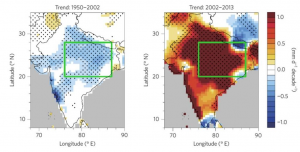Asia Weather
By Michael FaginRain Patterns MonsoonAsia Weather and rainfall patterns of the Asian monsoon, it’s increasingly being found, are dominantly steered by differences in temperature between northern India and sea surface waters. The differentiation makes pressure differentials, which stir winds and develop rainy weather patterns.
The last fifteen years have been a welcomed reprieve from the previous fifty-year dip – of an average deficit of 0.18 mm per decade, softened by a few rainy years – away from mean rainfall totals. Since then, an average of 1.34 mm per decade over the mean has nearly recovered India from its late-20th Century dry spell.
Another continuing change that began during the dry spell, starting in the 1980s, is the gradual westward shift of the Indian monsoon, which causes a restructuration of the atmospheric engine, augmenting details like local accumulations and arrival/departure times.
Why Are the Rainfall Patterns of the Asian Monsoon Becoming More Giving?
The rainfall patterns of the Asian Monsoon have moderately intensified since 2002 largely due to a favorable land-ocean temperature gradient. Higher land temperatures – due to a reduction of low-level cloud cover from reduced evaporation over the Arabian Sea – play an important role in the change. This year, a warm May and June modestly warmed northern India. Generating the other extreme, pre-monsoon sea surface temperatures didn’t warm as fast as normal due to oceanic circulations. During the fifty-year dip, cooler temperatures (0.04°C per decade) were present in northern India and pre-monsoon sea surface temperatures warmed faster.

Asia Weather Patterns
In general, low-level cloud cover over India has diminished in recent years. The popular culprit of the reduction is the Indian subcontinent’s increased dispersal of sunlight-absorbing atmospheric aerosols, like soot and black carbon, from urbanization and other sources of carbon emissions. The extra evaporation fights against the earliest stages of the formation of precipitation. Additional atmospheric particuli also dilute the supply of supercooled water that can be grabbed high in the sky, which can make more nascent rain but lowers its size. Lowering the size of nascent rain reduces both its resistance to evaporation and its impetus to fall.
The data collected by the study represents a departure from the predictions of global climate models and also clues toward the nature of the discrepancy: unaccounted for and unmodeled variables relating to the revival of the Asian Monsoon and its correlations with the land-ocean temperature gradient.
When Will the Rainfall Patterns of the Asian Monsoon Change?
Will the monsoon dry out again anytime soon? The same study mentioned previously proclaims the observed changes in the Indian monsoon are unrelated to inter-decadal changes. From what is understood about the causes of the recent change, the study finds the present pattern may prevail for several years or perhaps longer.
The wetter weather is wonderfully fortuitous for farmers and the hungry but has instigated serious flooding in some localities, especially along flood-prone areas. The state of Gujarat is seeing what is being described as “the worst flood of the century.” Flooding in northeastern India has left half a million Indians homeless. Hundreds of millions of dollars in flood insurance claims will likely surface by the conclusion of monsoon season 2017.
Written by Meteorologist Geoff Linsley
